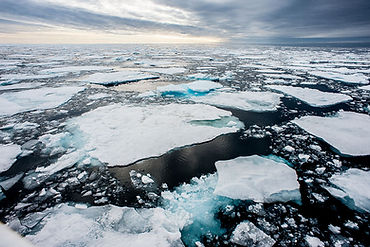By: Samuel Lin
Inside a glacier, a vast plain of snow and ice, there is a flourishing ecosystem waiting to be discovered. Ancient microscopic organisms crawl and swarm over and under the glacier, some trapped between and glacier and the ground, frozen in time. Yet when these glaciers slowly melt, all the pollutants are released, as well as these dangerous microorganisms that will release harmful pollutants themselves.
Humans are releasing harmful carbon dioxide, methane, and mercury into the air. The ice caps can mitigate the damage of the pollutants by absorbing them. However, when the ice caps melt, the pollutants react in the ice and can release more potent “mutant” pollutants back into the atmosphere.
Melting ice releases a lot of carbon dioxide. In NOAA’s annual Arctic Report Card, they found that one to two billion tons of carbon dioxide were emitted from melting Arctic Ice in 2019. That is more carbon dioxide than Japan emits in a year!
“We are seeing the rerelease of old contaminants that have been locked up in ice for many decades,” said Crispin Halsall, the Director of Natural Sciences at Lancaster University.
Methane is also being released in the Greenland ice sheets, which is losing about 270 billion tons of ice per year, according to NASA. In a study published in Nature, researchers took samples of the meltwater runoff from the glacier and found six tons of methane in the water runoff.
This is because when a glacier melts, it reveals frozen permafrost rich in organic matter. The microbes use the organic matter for respiration, and release methane as a by-product, which is a greenhouse gas that can trap 30 times more heat than carbon dioxide! This creates a negative feedback loop; global warming leads to melting ice caps and methane emissions, which leads to even more global warming, and the cycle continues.
Mercury is an example of another pollutant released by melting ice. According to the US Geological Survey, the concentrations of mercury in the ice sheets are two times that in the atmosphere. Mercury can harm and kill wildlife because it will bioaccumulate in animals like fish and birds.
“We’ve found, for some pollutants, the products they turn into can actually be more toxic than the original,” said Amanda Grannas, a chemist at Villanova University.
The breakdown of pollutants can be detrimental to the environment. For instance, microplastics can react with sunlight and break down into even more microplastics. These smaller microplastics are more dangerous because they smaller microplastics can be even sharper and cut and kill animals like fish.
In Science Direct, Grannas and her colleagues explained how in glacier ice, the pollutant aldrin will break down into even more dangerous pollutant dieldrin. Dieldrin once used as an insecticide, stays in the environment forever, and is toxic to many animals.
Sources:
https://www.wired.com/story/pollutant-degradation-ice-cores-antarctica/
https://phys.org/news/2019-01-ice-sheets-tons-methane-atmosphere.html
https://massivesci.com/articles/glacier-melt-toxic-chemicals-tibet/
https://www.bbc.com/future/article/20190612-the-poisons-released-by-melting-arctic-ice











